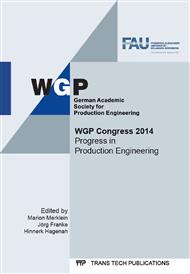p.341
p.351
p.357
p.365
p.373
p.381
p.387
p.395
p.403
Evaluating Mobile Machine Tool Dynamics by Substructure Synthesis
Abstract:
Mobile machining solutions use autonomous machining units that can be transported to different part locations, making possible easy maintenance and repair of large industrial equipment. Every new part and location results in different boundary conditions for the mobile machine tool-part system; influencing the dynamics of the combined system and necessitating different strategies for part/machine referencing and clamping. To facilitate efficient mutability and modularity in mobile machining solutions, this paper presents a dynamic substructuring strategy that combines the response characteristics of the mobile machine unit with that of two different simulated base models under varying levels of contact stiffness and damping to obtain the synthesized mobile machine tool dynamic response. Numerical verification of the approach is provided. Framework presented can also combine measured response of parts for which models may not be available a priori. Methods presented provide experimental guidelines for establishing strategies for part/machine referencing, and planning of machining strategies based on the evaluated dynamics.
Info:
Periodical:
Pages:
373-380
Citation:
Online since:
September 2014
Authors:
Keywords:
Price:
Сopyright:
© 2014 Trans Tech Publications Ltd. All Rights Reserved
Share:
Citation:


